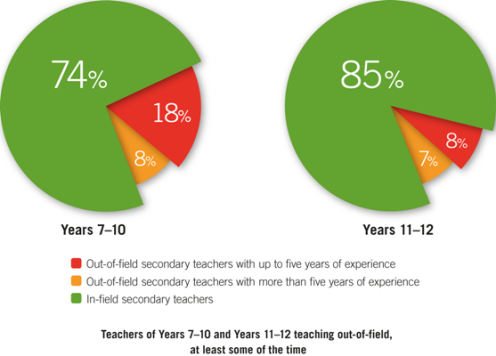
Measuring the extent of out-of-field teaching
Research 24 Aug 2016 4 minute readA new ACER report investigates the extent to which Australian secondary school teachers are teaching subjects other than those in which they have specialised. Paul Weldon explains.
Measuring the extent of out-of-field teaching
There is currently a great deal of interest in teacher quality in Australia and internationally. Teachers are expected to have a thorough understanding of the subjects they teach, as research has shown this is a key attribute of highly effective teachers. Teaching out of field – that is, teaching in a subject area in which a teacher has not specialised – is therefore of considerable concern.
The ACER report, Out-of-field teaching in Australian secondary schools – an initiative of the Centre for Education Policy and Practice – analyses the results from the 2013 Staff in Australia’s Schools (SiAS) survey to assess the proportion of secondary students affected by out-of-field teaching in selected subjects.
Out-of-field teaching by year level
The report shows that the extent of out-of-field teaching differs considerably between Year 7–10 and Year 11–12 classes.
About 26 per cent of teachers at Years 7–10 are teaching a subject in which they have not specialised, while about 15 per cent of teachers at Years 11–12 are teaching out of field.
Early career teachers are more likely to be teaching out of field than more experienced teachers, with 37 per cent of Year 7–10 teachers with one to two years of experience teaching a subject out of field compared with 25 per cent of teachers with more than five years of experience.

Out-of-field teaching by location
The extent of out-of-field teaching increases with distance from metropolitan locations. In remote locations, about 26 per cent of class groups are taught by an out-of-field teacher compared with 14 per cent in metropolitan locations.
This is likely to be linked, in part, to a higher number of early career teachers teaching in rural and remote locations, where there are typically a greater number of smaller schools and consequently a greater need to provide classes over a range of subjects, which is likely to necessitate out-of-field teaching.
The incidence of out-of-field teaching tends to be slightly higher in schools in low socioeconomic status (SES) locations. Of class groups in schools in low-SES locations, 19 per cent have an out-of-field teacher compared with 13 per cent in schools in high-SES locations.
Out-of-field teaching by subject
Subjects with a high incidence of out-of-field teaching include:
- Media (41 per cent)
- Geography (40 per cent)
- Religious Studies (38 per cent), and
- Information Technology (34 per cent).
About one-quarter of teachers are out-of-field in Languages, History, Graphic Communication, Computing and Social Studies.
For some areas, out-of-field teaching is a product of the way subjects are taught at school. For example, Mathematics is taught to all students in all year levels at every secondary school. As a result, even schools with several qualified mathematics teachers may find they are unable to cover every class.
Since the generic subject Studies of Society and Environment (SOSE) or Human Society and Its Environment (HSIE) has been standard at the lower secondary level for many years, it is not surprising that SOSE or HSIE teachers will have indicated that they teach one or more of History, Geography and Social Studies out of field. Of SOSE or HSIE subjects, Geography is most likely to be taught by teachers who have not undertaken second-year tertiary study in the subject (54 per cent).
Lessons for further research
There is currently strong growth in student numbers in most states and territories in Australia, and demand for secondary teachers will increase during the next 10 to 15 years. In light of recent work to improve the quality of initial teacher education, further work is required to better understand the demand for teachers across different subjects and the nature of the pressures on schools that cause out-of-field teaching.
As well as collecting additional data on the extent and distribution of secondary teachers by subject, it would be worth investigating how schools manage resourcing and timetables to learn from successful solutions, and to provide indicators of best practice that could reduce the incidence of out-of-field teaching.
Further information:
Read the full report, Out-of-field teaching in Australian secondary schools, by Paul Weldon.
Learn more about the Staff in Australia’s Schools survey.
Learn more about the Centre for Education Policy and Practice.